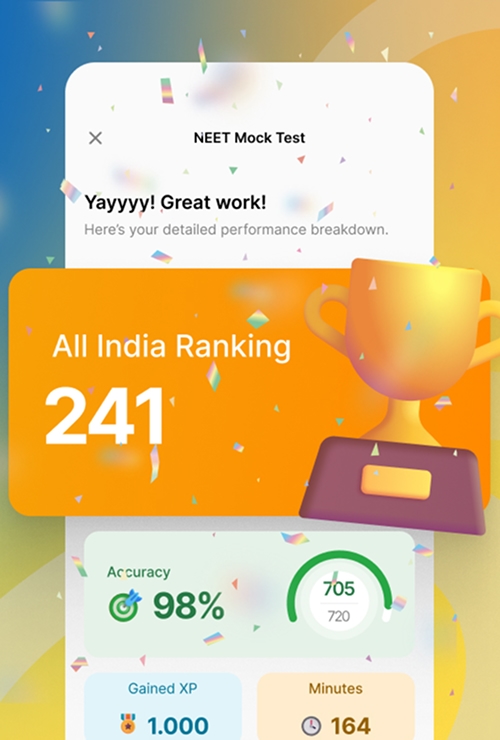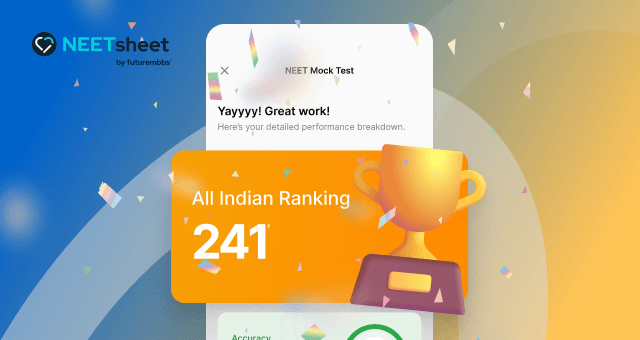
☝️ At a glance
- Structured planning is key: MBBS students should create personalized study plans, use concise notes, and stick to schedules to manage complex subjects and vast syllabi effectively in the online mode.
- Smart use of digital tools: Leveraging video lectures, flowcharts, and 3D learning aids enhances understanding, especially for anatomy and other first-year subjects.
- Interactive e-lectures boost engagement: Teachers should use quizzes, case-based discussions, and visual aids to make online medical classes more engaging and practical.
- Balance: Regular MCQ practice, doubt-clearing sessions, and staying connected with peers and mentors help reduce overwhelm and build a strong foundation for a successful medical career.
The COVID-19 pandemic triggered a massive shift in how MBBS students engage with medical education. As physical classes gave way to digital learning environments, adapting to this new format became essential. For medical students, especially those in the early phases of their MBBS journey, this change brought new challenges—but also new opportunities.
This guide provides actionable e-learning tips for MBBS students to enhance online learning, especially in the context of competency-based medical education (CBME).

Become a global doctor with MBBS abroad!
Studying abroad can be affordable and stress-free with futureMBBS:
- World-recognized universities with English-taught programs
- On-site support in partner university cities
- Guaranteed placements & internships for hands-on experience
From selecting universities and supporting you with the application process to orientation and finding accommodation – we are at your side.
Why e-learning?
The rise of online mode in medical school
The traditional model of face-to-face instruction has been restructured into a hybrid or fully online model, particularly after the second wave of COVID-19. Video lectures, interactive simulations, and mobile applications like PW Med Ed have become key tools for MBBS students, transforming how medical education is delivered.
The need for effective digital strategies
While studying MBBS online, it’s easy to feel overwhelmed due to the volume of complex concepts, particularly in first-year subjects like anatomy, physiology, and biochemistry. That’s where a structured e-learning strategy becomes essential for success.

Study medicine abroad with 100% support!
futureMBBS offers full support to make your dream of studying medicine abroad a reality.
- Hassle-free admission guidance
- Fast-tracked visa processing
- Post-arrival support, including accommodation assistance
Top e-learning tips for MBBS students
1. Create a personalized study plan
Break your schedule by subject: anatomy, physiology, and biochemistry.
Allocate more study time to weak areas.
Use digital tools like Google Calendar or PW Med Ed app reminders.
Make sure your plan includes breaks to avoid burnout.
A consistent schedule is key to mastering theory and practical aspects.
2. Use concise notes and flow charts
Make digital flashcards for quick revisions.
Create flow charts and diagrams to visualize the human body and physiological processes.
Stick to concise notes that focus on high-yield, exam-relevant points.
This enhances retention and speeds up revision, especially during exam day preparation.
3. Leverage quality online resources
Use standard books to complement YouTube video lectures.
Access medical animations and 3D models to understand complex concepts better.
Refer to platforms like PubMed Central for hospital-based research articles and case studies.
Online learning platforms should supplement—not replace—textbook learning.
Tips for conducting effective e-lectures in medical education
For teachers and faculty members of medical colleges, delivering impactful e-lectures requires more than just presenting slides. Here’s how to ensure students stay engaged and build a strong foundation:
Use interactive tools
Polls and quizzes (e.g., MCQs after each topic).
Live chat to allow real-time Q&A.
Breakout rooms for group discussions on particular subjects.
These strategies replicate classroom interaction and help students apply knowledge actively.
Focus on practical applications
Demonstrate real-life clinical cases using images or case studies.
Relate theoretical concepts to hospital scenarios.
Encourage solving MCQs based on the lecture.
Interactive case discussions help bridge the gap between theory and real-world practice.
Integrate visual learning aids
Include diagrams, animated videos, and clinical photographs in presentations.
Use digital whiteboards for drawing anatomical structures.
This is especially helpful in understanding anatomy and other basic subjects.
Understanding complex concepts in less time
Break down content into bite-sized lectures
Shorter lectures (10–15 minutes) focusing on a single topic are more digestible than long, drawn-out sessions. Focused videos help students concentrate better and retain concepts more efficiently.
Relate to clinical relevance
Always ask: “Why am I learning this?” Connecting subjects to real-world clinical settings makes topics more meaningful, especially for first-year students.
Preparation tips for exams in the online learning era
Practice with MCQs and sample tests
Use platforms offering daily quizzes and timed mock tests.
Analyze your mistakes and focus on weak areas.
Solve topic-wise MCQs after watching each lecture to reinforce concepts.
This technique is essential for NEET PG and other competitive exams.
Stick to standard books and essential topics
Avoid trying to cover everything at once—prioritize important topics.
Focus on the theory that’s frequently tested in exams.
Use concise notes during final revisions.
Simulate exam conditions
Use a timer while solving practice questions.
Avoid distractions—treat your home environment like an exam hall.
Tips for practical subjects in the online mode
Watch procedure videos regularly
Learn techniques like venipuncture, suturing, and CPR through reputable video content.
Repeat the videos as necessary to reinforce steps visually.
Use virtual dissection tools
Apps and tools now offer virtual cadaveric dissections and 3D anatomical maps.
A boon for MBBS 1st year students missing out on in-person dissection labs.
Managing life and learning: Balancing study and well-being
Don’t skip breaks
Breaks enhance productivity and reduce burnout.
Use techniques like Pomodoro (25 minutes study, 5 minutes break).
Stay connected with peers
Join online study groups and WhatsApp/Telegram communities.
Discuss doubts regularly and share tips for studying MBBS online.
Collaboration enhances understanding and reduces the feeling of isolation.
Consult teachers frequently
Attend doubt-clearing sessions.
Send questions via email or group chats if live clarification isn’t possible.
Staying connected with mentors helps you stay ahead in your medical career.
Common challenges and how to overcome them
1. Poor internet and technical issues
Download lectures for offline viewing.
Keep backup notes and recorded classes in case of disruptions.
2. Lack of focus in online mode
Turn off notifications during study time.
Use full-screen mode and headphones to maintain attention.
3. Feeling overwhelmed
Break large chapters into smaller goals.
Celebrate small wins (e.g., finishing one chapter, solving 50 MCQs).
Building a strong foundation for future practice
Focus on core understanding, not just passing
Learning should not just be about clearing anatomy exams or 1st-year theory—it’s about understanding the human body deeply for future hospital settings.
Keep your long-term goals in sight
Whether it's NEET PG, a research-based career, or specialization, online resources should align with your goals.
Track your progress and re-align your study plan monthly.
Summary of key e-learning tips for MBBS
Strategic tips
Stick to a study schedule and track your progress.
Use concise notes, flow charts, and MCQs for better understanding.
Content-based tips
Use short, focused video lectures.
Relate topics to practical and clinical applications.
Tool-based tips
Leverage the PW Med Ed app and standard online resources.
Use animations, 3D tools, and interactive quizzes.
Teacher and peer support
Actively engage in e-lectures using chat and polls.
Discuss doubts with peers and instructors regularly.
Conclusion
As MBBS students adapt to this new normal, the online mode of learning offers an unprecedented opportunity to gain a flexible, accessible, and personalized medical education. The key lies in optimizing time management, using high-quality resources, and staying consistent. With a strong foundation built through e-learning, future doctors can not only ace their exams but also become skilled, empathetic healthcare professionals.
Aspiring for top medical colleges? NEETsheet’s practice app is designed to give you an unbeatable edge! Whether you're a NEET dropper looking for redemption or a student preparing for the first attempt, our NEET app offers the perfect blend of previous year questions, mock tests, test series, and question bank with 10,ooo plus questions—all tailored to help you master the entire NEET syllabus.
NEETsheet app makes quality NEET coaching accessible that will build a strong foundation for top ranks.
Don’t just prepare—dominate NEET 2026 with NEETsheet app.
Your medical career abroad starts here!
Thinking of pursuing MBBS abroad? Don’t just dream it, do it!
Start your MBBS journey!FREQUENTLY ASKED QUESTIONS
FAQs about "e-learning tips"
1. How can MBBS students stay focused during online classes?
Use full-screen mode, turn off phone notifications, take notes actively, and use tools like the Pomodoro technique to stay engaged.
2. What are the best online platforms for MBBS e-learning?
Apps like Marrow(MBBS), and NEETsheet(NEET) along with video platforms like YouTube Medical Lectures and 3D Anatomy Tools offer great support for understanding complex topics.
3. How should first-year MBBS students manage their study schedule online?
Divide time among core subjects (anatomy, physiology, biochemistry), include time for solving MCQs, revisions, and short breaks. Stick to a realistic daily timetable.
4. Are video lectures enough for MBBS exam preparation?
Video lectures help with concept clarity but should be combined with standard books, concise notes, and practice questions for complete preparation.
5. How can MBBS students improve their understanding of complex subjects like anatomy in online mode?
Use 3D visual tools, animated videos, and flowcharts, and revise with concise notes regularly. Virtual dissection apps also help build strong anatomical understanding.







